Home Tycoon!
by BONZO, HSM team writer
Hellfire Games surprised us by dropping a Tsar Bomb with the announcement of Home Tycoon, coming soon.
This is the kind of in Home game I have longed to see, and I’m sure I’m not alone. One of my favorite mobile games — and somewhat of a guilty pleasure — is Smurfs’ Village, where you develop and grow your own little village of Smurfs scampering about. I always wanted to see something like that in Home. An expansion of a Mui Mui island, where the little inhabitants responded to the decisions you make to their environment. Or even see Lego in partnership with Home and a Lego version of Minecraft within the Home universe that allowed you to freely create within a limited environment.
Home Tycoon looks to come very close to that. The possibilities are there: we can decorate our own spaces in any number of customizable ways, and many have made a game of using decor props to build their own sub rooms, mazes or forts in a personal space. The idea that you can build an entire city is mind-boggling and brings forth to mind so many unanswered questions taunting us from the eight slides you browse through at the Hellfire E3 kiosk.
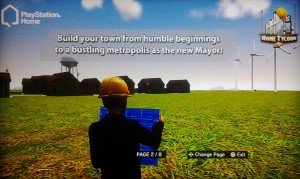 For one thing, you see an avatar in a hard hat holding up a blueprint, in a large, seemingly endless open field. Monopoly-esque cookie-cutter track housing in the distance, energy windmills, a water tower and a seemingly endless horizon all beg the question: how big is this going to be? The scale is unclear and leaves it open to a lot of speculation. There are memory constraints in Home development; hence why there is a lot of compartmentalization, and a huge open space hardly seems possible within these limitations.
For one thing, you see an avatar in a hard hat holding up a blueprint, in a large, seemingly endless open field. Monopoly-esque cookie-cutter track housing in the distance, energy windmills, a water tower and a seemingly endless horizon all beg the question: how big is this going to be? The scale is unclear and leaves it open to a lot of speculation. There are memory constraints in Home development; hence why there is a lot of compartmentalization, and a huge open space hardly seems possible within these limitations.
What is the perspective going to be? Is the avatar in place merely a suggestive representation of your control over the development of the city? If you look at the textures, they don’t hold up to the current generation standards of extensive detail. In fact they don’t hold up to the standards of Home minutiae. In the aforementioned field, the grass texture is unrealistically large and disproportional to the blades on the energy windmills. The houses in the distance appear to be miniature houses. How does this work?
So let’s consider the mechanics of the game. How do we do this without seeing it in action? By comparing it to Hellfire’s existing Home game, Novus Prime.
Novus Prime is a massively-scaled space shooter. But is it? It starts out looking massive, as the ship in the dock is easily a couple of hundred times the size of your avatar. Consider, however, that the camera zooms out to an overview perspective, and the scale changes, making your ship seem tiny in comparison. You fight much larger ships, but again this is an alternative perspective as your viewpoint is altered. The mechanics of the game work in this way to compensate for the memory restrictions.
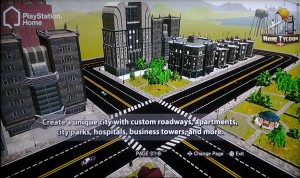 So everything during the game is scaled down; if the scale remained consistent and the memory allotment allowed for it, you might be playing the game from the cockpit of your ship in a totally different perspective. The camera is placed where it is, at the scale which it is because it makes it easier to hide the absence of texture details in scaled down models.
So everything during the game is scaled down; if the scale remained consistent and the memory allotment allowed for it, you might be playing the game from the cockpit of your ship in a totally different perspective. The camera is placed where it is, at the scale which it is because it makes it easier to hide the absence of texture details in scaled down models.
When you browse to the third slide you see a bird’s eye view of a city. A few buildings, and intersection of roads and a few cars on the street. This again looks miniature in comparison to the detail textures of the Home public spaces. But more familiar to the design aesthetics of the Novus Prime universe. This slide makes the claim that you will be able to design you own unique city, with custom roadways, apartments, city parks, hopitals, business towers, and more. We have to keep in mind the limitations of Home development. Memory is an issue, and so the prospect of a miniature city is looking more likely to be the case.
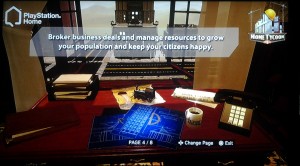 The following slide shows the interior of an office with a view of a city street through the window, beyond that an open field and rolling hills, but even from this distance I can see the grass texture on the hills. The interior of the office is more intricately textured because it is closer. On the desk sits a few blueprints, and a map with a train car miniature sitting on top of it like a paperweight. Could this indicate that the miniature city speculation is more apt?
The following slide shows the interior of an office with a view of a city street through the window, beyond that an open field and rolling hills, but even from this distance I can see the grass texture on the hills. The interior of the office is more intricately textured because it is closer. On the desk sits a few blueprints, and a map with a train car miniature sitting on top of it like a paperweight. Could this indicate that the miniature city speculation is more apt?
Take a look at the next slide, where the message states “Meet with others at the Home Tycoon train station to visit other cities, compete on the leader boards, and show off your rewards!” More importantly, take a look at the texture maps on the environment, from the floor to the pillars to the train itself. Much more detailed, and scaled up. This suddenly looks much more like a public space in Home now.
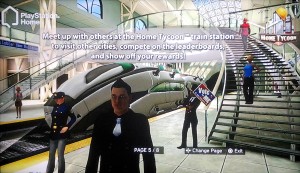 In fact, you see avatars in various distances from the camera as a scale comparison. In the previous slides you didn’t see any avatars freely exploring the city. The message brings more questions to mind, stating you can visit other cities, and the word that caught my digital hoarding attention: rewards. I don’t care for leaderboards; I don’t have to prove myself to be the best. I just like collecting stuff. Visiting other cities is interesting, though; will you be able to visit anyone’s city, a featured city, only your friend’s creations, or by invitation only?
In fact, you see avatars in various distances from the camera as a scale comparison. In the previous slides you didn’t see any avatars freely exploring the city. The message brings more questions to mind, stating you can visit other cities, and the word that caught my digital hoarding attention: rewards. I don’t care for leaderboards; I don’t have to prove myself to be the best. I just like collecting stuff. Visiting other cities is interesting, though; will you be able to visit anyone’s city, a featured city, only your friend’s creations, or by invitation only?
(You’d be surprised. –Editor)
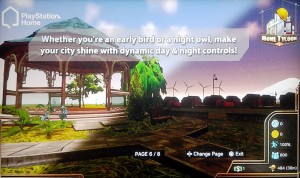 In the next slide we get a close up of a gazebo, presumably in one of the previously-stated parks we will be able to create. Notice the level of detail in the model. If you don’t know how 3D games work, or how 3D models are composed, they are a series of interconnected polygonal planes in either triangular or quadratic shapes. The more polygons you have, the more detail a 3D model will have. The number of polygons is limited by the processing power of the rendering engine. Hence why the characters in first-generation PlayStations looked so boxy, and the level of detail in game characters has grown exponentially with each generation. If you look closely at this gazebo, it looks very primitive in comparison to public space props. Even the plants look angular and inorganically geometric. This slide gives us a hint at the user interface with a heads up display on the bottom right side of the screen.
In the next slide we get a close up of a gazebo, presumably in one of the previously-stated parks we will be able to create. Notice the level of detail in the model. If you don’t know how 3D games work, or how 3D models are composed, they are a series of interconnected polygonal planes in either triangular or quadratic shapes. The more polygons you have, the more detail a 3D model will have. The number of polygons is limited by the processing power of the rendering engine. Hence why the characters in first-generation PlayStations looked so boxy, and the level of detail in game characters has grown exponentially with each generation. If you look closely at this gazebo, it looks very primitive in comparison to public space props. Even the plants look angular and inorganically geometric. This slide gives us a hint at the user interface with a heads up display on the bottom right side of the screen.
You see a silver coin, a gold coin, a little humanoid graphic with a briefcase with a line graph trail behind him and a “100%” indicated. I can only assume this is the scale of work productivity currently running in the game which will generate the currency you can spend on new developments. Below that is a graphic of simplified people much as a social icon often used in social gaming or social networks; this I have to assume represents your current city population. Below that icon is a hard hat graphic with a wrench, indicating work force? Since the work force is generally a smaller percentage of the total population, and the population number is 800 compared to the 484 of the labor icon, I’m guessing that assumption must not be too off the mark. To the right of the number is another number with 38m in parentheses, indicating minutes? Perhaps that is something like the progression times on structure building in games like SimCity, where the complexity of the building determined the amount of time it took to build. Interestingly enough, to the left of that icon is a dollar — so we differentiate between silver coin, gold coin, and a dollar. My guess is the dollar will be the micro-transaction method. Many freemium games have this differentiation between in-game currency and premium currency. Currency you pay real money for and use sparingly.
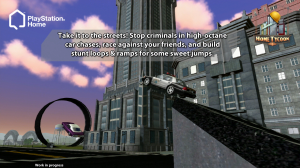 The next slide shows us a police car chasing an unofficial vehicle, the slogan states “…Stop criminals in high-octane car chases, race against your friends, and build stunt loops & ramps for some sweet jumps.” The assumption would be that if you grow tired of developing, as there is only so much you can do before it gets old, you will be able to engage in mini-games within Home Tycoon. I am guessing that developing wont be instantaneous either. As with many other freemium games, I will venture a guess that you will lay out the development site, pick your development venture, and it will take a suitable amount of time for your workforce to construct the development. In the meantime, while your workforce is busy, you can explore other mini-games like chasing criminals, building ramps and racing friends.
The next slide shows us a police car chasing an unofficial vehicle, the slogan states “…Stop criminals in high-octane car chases, race against your friends, and build stunt loops & ramps for some sweet jumps.” The assumption would be that if you grow tired of developing, as there is only so much you can do before it gets old, you will be able to engage in mini-games within Home Tycoon. I am guessing that developing wont be instantaneous either. As with many other freemium games, I will venture a guess that you will lay out the development site, pick your development venture, and it will take a suitable amount of time for your workforce to construct the development. In the meantime, while your workforce is busy, you can explore other mini-games like chasing criminals, building ramps and racing friends.
Hellfire actually gave us a lot more information than a simple teaser normally would, if you look closely. The prospect of building your own city is filled with possibilities; immediately my head was filled with the idea of exploring and running around my own constructed city. However if you think exploring the city will be anything like running around in any other Home space, that will not be the case. I am almost certain you will have control of the camera, but not an avatar running around the city. The graphics will probably be limited to a scaled-down miniature, and you will be working within a limited amount of space. Your population will likely be compartmentalized into laborers, general population, families, and businesses. Each in charge of different aspect of a social economy, like extracting or developing resources, consumerism, and you will be in charge of managing resources and spending. Each decision growing your population and your city, or collapsing it.
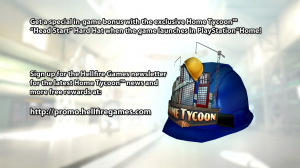 As the name suggests other similar type games, we can make an educated guess that the mechanics will work similarly to games like Rollercoaster Tycoon, City Tycoon, et cetera. Games where you have an omnipotent view of the city, managing small elements that end up affecting the progression of the simulated life in the game, with random events occurring from time to time which you will have to compensate for.
As the name suggests other similar type games, we can make an educated guess that the mechanics will work similarly to games like Rollercoaster Tycoon, City Tycoon, et cetera. Games where you have an omnipotent view of the city, managing small elements that end up affecting the progression of the simulated life in the game, with random events occurring from time to time which you will have to compensate for.
How will this work within the Home universe? Will this be a free to play game, or will it be a personal space you buy to start out in? Having to purchase the space doesn’t seem likely to a freemium format. My guess is that it will be free to play, but you will have to buy in-game dollars to expedite development, or purchase premium developments, to benefit the accumulation of in game currency. A similar transaction system to Cutthroats perhaps: instead of purchasing gold coins you purchase premium dollars, with different amounts available in larger bundles. There will likely be items you can only purchase with premium dollars, much as the format Farmville adopted with Farmville cash.
The angles of the images in the slides suggest you will have a lot of control over the placement of objects, and likely will not be fixed to a birds-eye view of the city. The only avatar seen in the city space is the man in a suit holding a blueprint, but on closer inspection this avatar is also missing a lot of the polish and textured detail most avatars have, suggesting perhaps there will be less detailed representations of your population in the city. Will they have an emotion meter? Will you have to keep them happy? Will they react differently if they are unhappy? The work production meter suggests this may be the case, with productivity decaying if the population is unhappy, with productivity low in game currency earnings will diminish affecting your development prospects and your city’s economic stability.
There are eight slides, but only six of them show any hint of Home Tycoon, and there are so many possibilities out of those six slides alone that it is difficult to narrow them down. This is an exciting prospect for Home, and the Home user. There are countless ways Hellfire can monetize from this venture, particularly since we haven’t seen anything like this in Home yet. The mayor’s office could be a personal space you purchase, which may grant you some bonus upgrades in the development of your city. They may sell additional premium content besides premium dollars, if they are indeed planning to sell in game premium dollars. Upgrades for buildings, or transportation systems, car packs, house packs with different house designs. The possibilities are endless, and this is all just speculation from six still images, but the excitement in uncontrollable because this sort of growth is the type of expansion Home needs.


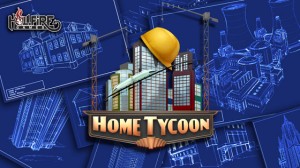
 Twitter
Twitter
Uh-oh, I’ve got a feeling I’m about to loose a lot of monies to Home in the next year!
I was addicted to SimCity on the SNES when I was a kid. I loved it so much, I neglected half my summer holidays to stay in perfecting the balance of the city. This is gonna suck me right in. So is Mercia, just had a go on the tutorial level in E3 about an hour ago, it’s looking good too.
I should be stupidly excited about all this, but all I’m thinking of is the vast sums of money Home will be sneaking out my wallet with its “micro” transactions lol.
I’m really looking forward to this game. There were lots of Home content at E3 that I’m really looking forward to seeing. Mercia, Dust, Home Tycoon…all looking snazzy and amazing.
Reward hunters should pay close attention to the train station slide. There’s a few hints to the rewards in that one. Vote for me sign, conductor outfit, Mayor’s outfit, hard hat, fireman’s hat, police outfit. The office slide too, the miniature train, and the blueprints.
Did you notice the sign in the upper left hand corner in the train station picture? I believe it says “Unavailable! New Building”. Curious. Also, on the page of blueprints, one of them says: “Name: Town Hall Type:B Stage: Rough”. I love these little clues.
mmmmmmm, possibilites! I’m in.
The ability to link your city to a friends city via the train thingies will be huge. Can’t wait for this!
As long as I can raid my friends cities with gangs of unruly th teens to loiter and cause general mayhem… I’m in!
Didn’t you just describe how Home is already?